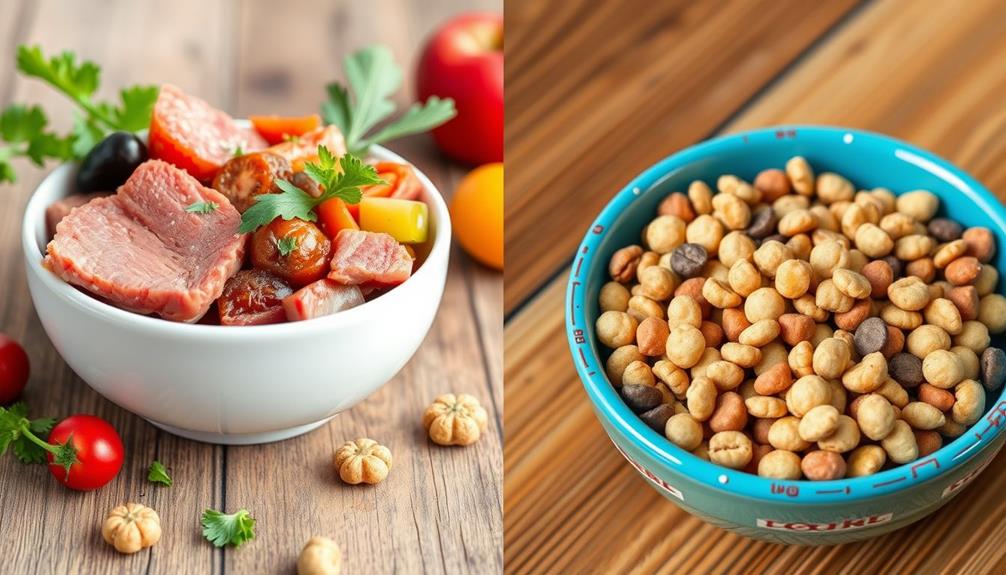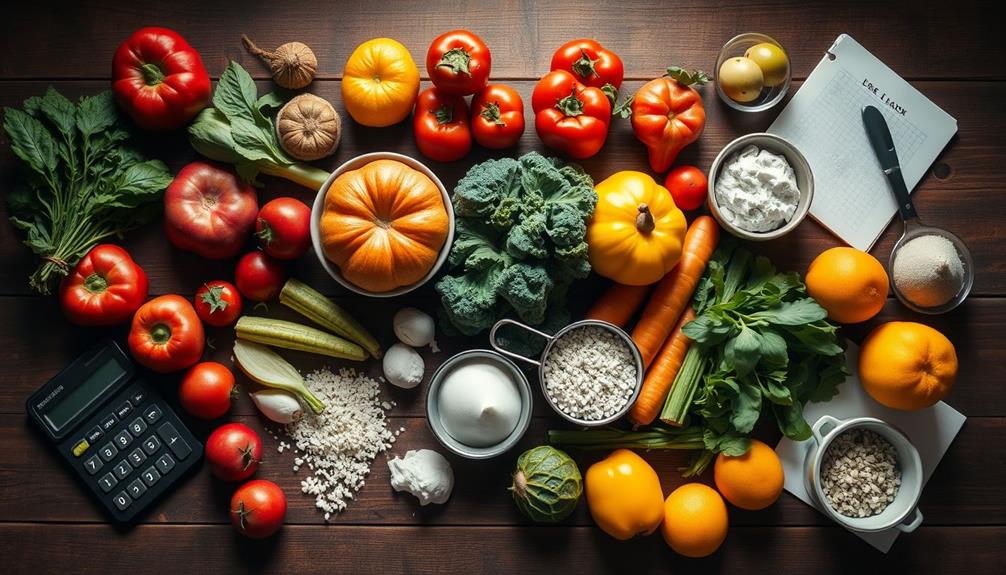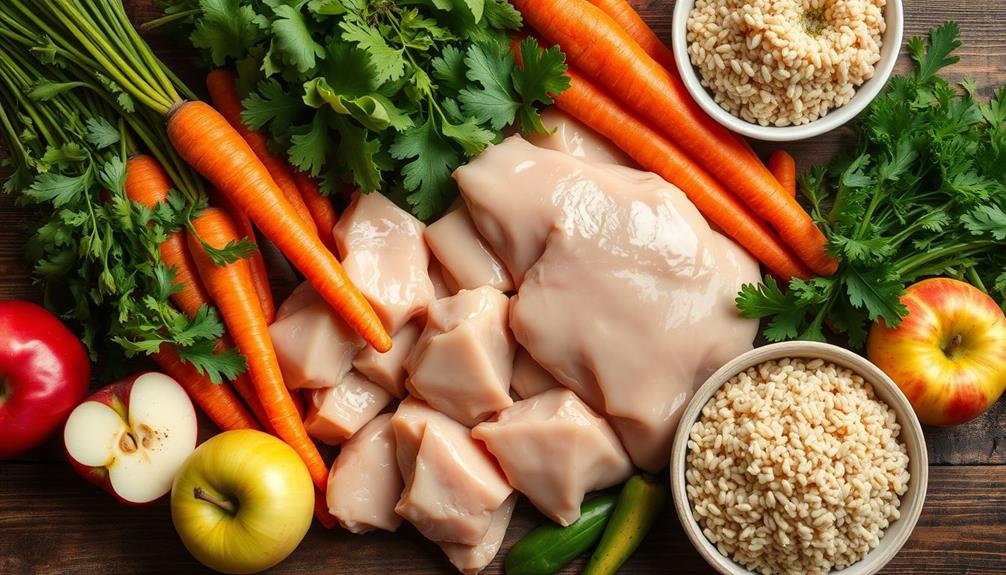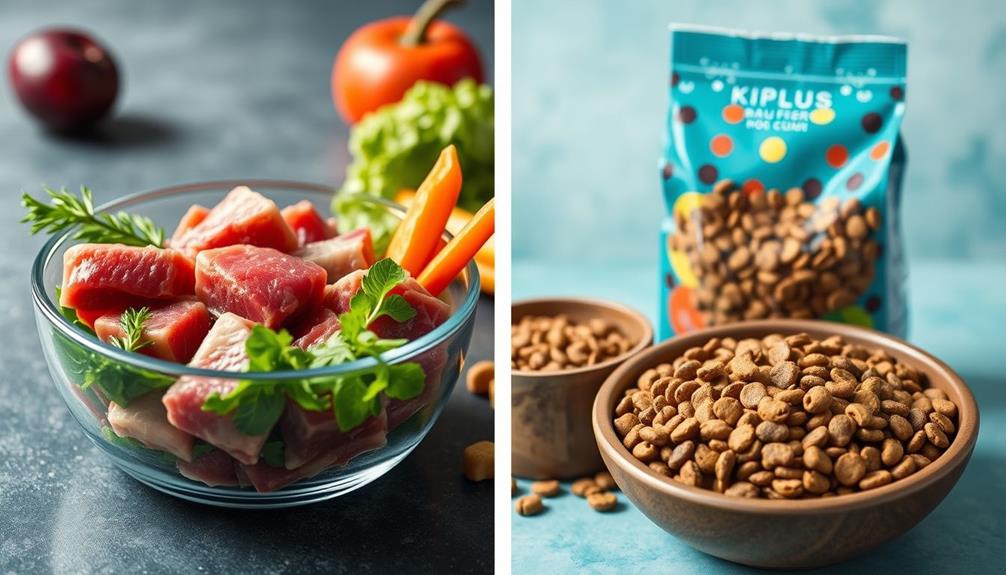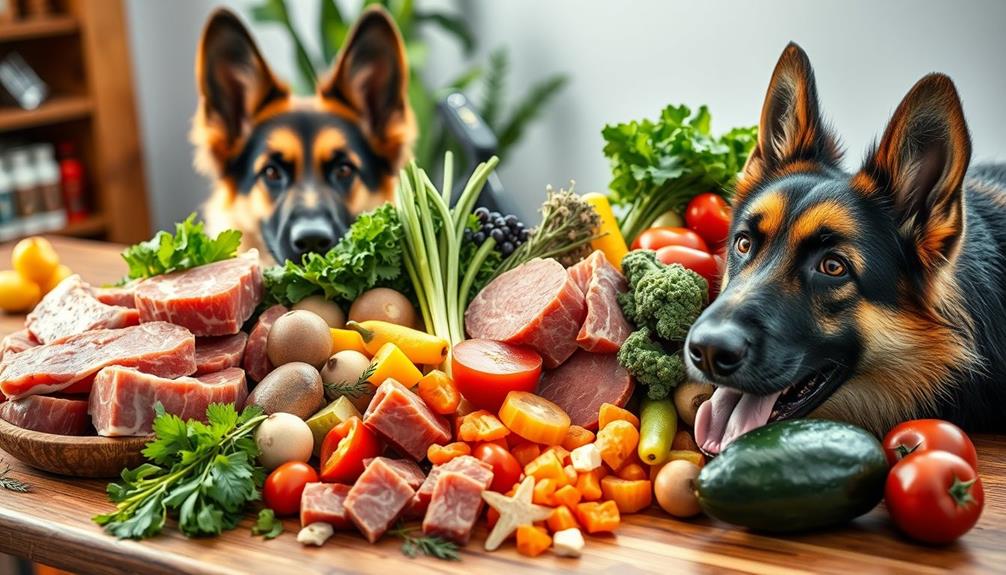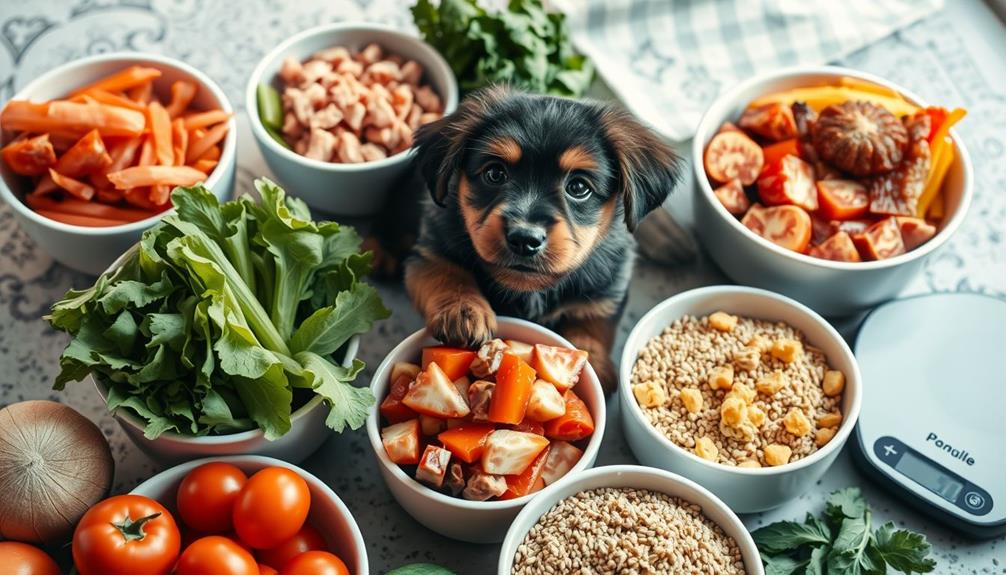When deciding between raw food and kibble for your dog, think about their specific dietary needs. Raw diets generally offer higher protein bioavailability and lower carbohydrates, which can lead to better digestion and energy levels. However, they require careful storage and hygiene to avoid pathogens. Kibble is convenient and has a long shelf life, but it often contains fillers and can lead to health issues if nutritional quality is poor. Ultimately, the best choice depends on your dog's health and your commitment to their diet. You might find that exploring each option further can reveal more insights tailored for you. Another factor to consider is the debate over raw vs cooked food for dogs. Some argue that cooking food can destroy essential nutrients, while others believe that cooking can eliminate harmful bacteria. It’s important to do thorough research and consult with a veterinarian to make an informed decision about your dog’s diet. Ultimately, the choice between raw and kibble, or raw vs cooked food for dogs, will depend on your dog’s individual health and dietary needs.
Key Takeaways
- Raw diets provide higher protein bioavailability and lower carbohydrate levels, promoting better overall health compared to kibble.
- Kibble is convenient and has a long shelf life, but often contains lower-quality ingredients and excessive carbohydrates.
- Raw food diets enhance hydration with 70-75% moisture content, whereas kibble has only 5-10% moisture.
- Transitioning to raw food requires careful planning and consultation with a veterinary nutritionist to ensure balanced nutrition.
- Fresh food alternatives offer a variety of nutrients and are typically more appealing to dogs than traditional kibble.
Overview of Dog Food Options
When choosing dog food, understanding the options available is fundamental for your pet's health. You've got a few main types to evaluate: kibble, raw diets, and fresh food. Each option has distinct characteristics that can influence your dog's nutritional value and overall well-being.
Healthy snacks can also complement your dog's diet, guaranteeing they receive a variety of nutrients and flavors to keep them engaged and satisfied healthy dog snacks.
Kibble is convenient and offers a long shelf life, but its nutritional value can differ greatly based on the quality of ingredients and processing methods. Many kibble brands contain high carbohydrate levels, which might lead to potential health issues over time.
Raw diets, on the other hand, consist of uncooked ingredients like meat, bones, and vegetables. They provide higher bioavailability of nutrients, aligning more closely with your dog's natural dietary needs.
The moisture content in raw diets is considerably higher—around 70-75%—which promotes better hydration compared to kibble's 5-10%.
Fresh food diets usually feature natural ingredients and often come as subscription-based meals. They require careful handling but can offer a balanced nutritional profile.
As a pet owner, weighing the pros and cons of these options is essential to guarantee your dog enjoys peak health and liveliness.
Benefits of Raw Dog Food
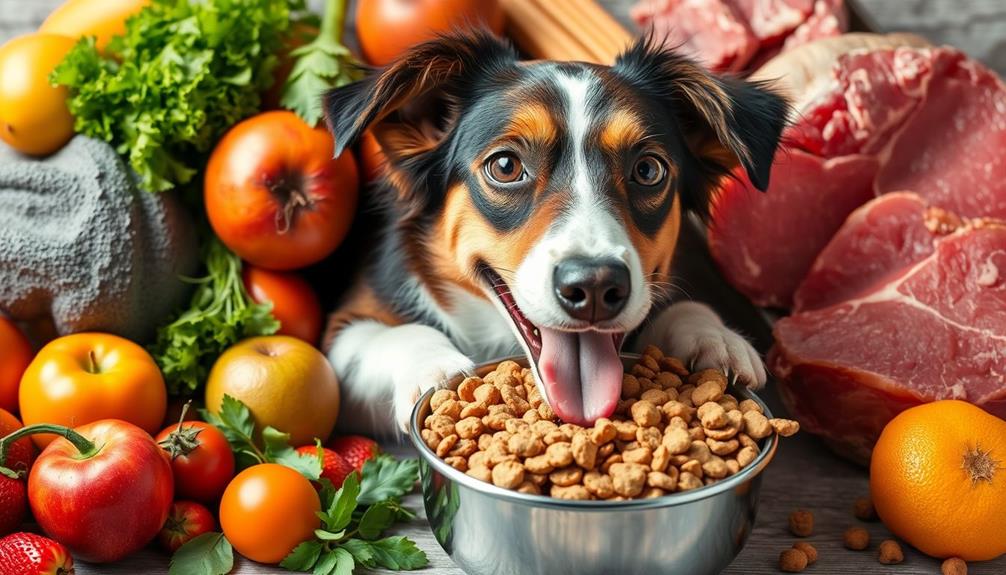
When you choose raw dog food, you're giving your pet a diet that's closer to what nature intended, which means higher protein bioavailability and better digestion.
This can lead to noticeable improvements in your dog's coat and energy levels. Additionally, raw diets often include natural ingredients that can help support your dog's immune system and may lead to fewer health issues, as seen in common types of cold medications.
Plus, the natural ingredients in raw food often help reduce allergy flare-ups and promote overall health.
Nutritional Advantages of Raw
Opting for a raw food diet for your dog can reveal a range of nutritional advantages that kibble simply can't match. Raw dog food is packed with high-quality protein sources, averaging 13-14% crude protein, which supports your dog's nutritional needs effectively. This natural composition closely aligns with your dog's ancestral eating habits, offering species-appropriate nutrition that's low in carbohydrates—typically under 10%.
Additionally, many pet owners have observed that a raw diet can contribute to improved overall health, similar to how proper care can benefit small animals like hamsters, as seen in the Ultimate Hamster Care Guide.
The health benefits of a raw diet are substantial. Many dog owners notice improvements in their pet's coat condition, dental health, and energy levels, while also seeing a reduced incidence of obesity and other health issues.
Additionally, raw food boasts a much higher moisture content, ranging from 70-75%, which fosters better hydration and overall health compared to the 5-10% moisture found in a kibble diet.
Moreover, shifting to raw food often leads to smaller, firmer stools, indicating better nutrient absorption. This clear advantage in digestion means your dog is likely getting more out of their meals, making raw dog food a compelling choice for peak canine health.
Improved Digestion and Absorption
Improved digestion and absorption are key benefits of feeding your dog a raw food diet. With moisture levels ranging from 70-75%, raw diets promote hydration, which is crucial for ideal digestion. In contrast, kibble only contains about 5-10% moisture, making it less effective in this regard.
The protein found in raw diets is typically more bioavailable, averaging 13-14% crude protein, enhancing nutrient absorption and overall digestion for your dog. Additionally, incorporating essential oils for digestive support can further benefit your dog's gut health.
Moreover, raw diets usually consist of single meat source proteins, minimizing the risk of allergy flare-ups and contributing to better digestive health. The natural enzymes present in raw food further aid digestion and nutrient absorption, while these necessary enzymes are often destroyed during the high-heat processing of kibble.
Additionally, the absence of fillers and artificial preservatives in raw diets helps to prevent digestive upsets, ensuring a more natural, species-appropriate diet for your furry friend.
Enhanced Coat and Energy
Feeding your dog a raw food diet can lead to noticeable improvements in both coat condition and energy levels. The crucial fatty acids found in fresh meats and fats contribute to an enhanced coat that's shinier and healthier. You'll notice that your dog's skin becomes less dry and flaky, thanks to the bioavailable nutrients in raw diets.
Moreover, the high moisture content in raw food—up to 70-75%—helps improve hydration, which is important for overall coat health. As you watch your dog thrive, you might also observe a significant boost in energy levels. Raw diets are packed with high-quality protein and nutrient density, promoting ideal metabolic function and liveliness.
Here's a quick comparison to illustrate these benefits:
| Benefit | Raw Diets |
|---|---|
| Coat Condition | Shinier, healthier coat |
| Hydration | 70-75% moisture content |
| Energy Levels | Increased liveliness |
| Nutrient Absorption | Enhanced due to natural enzymes |
Many dog owners report these improvements within weeks of switching to a raw food diet, showcasing the immediate benefits of this nutritional approach.
Challenges of Raw Diets
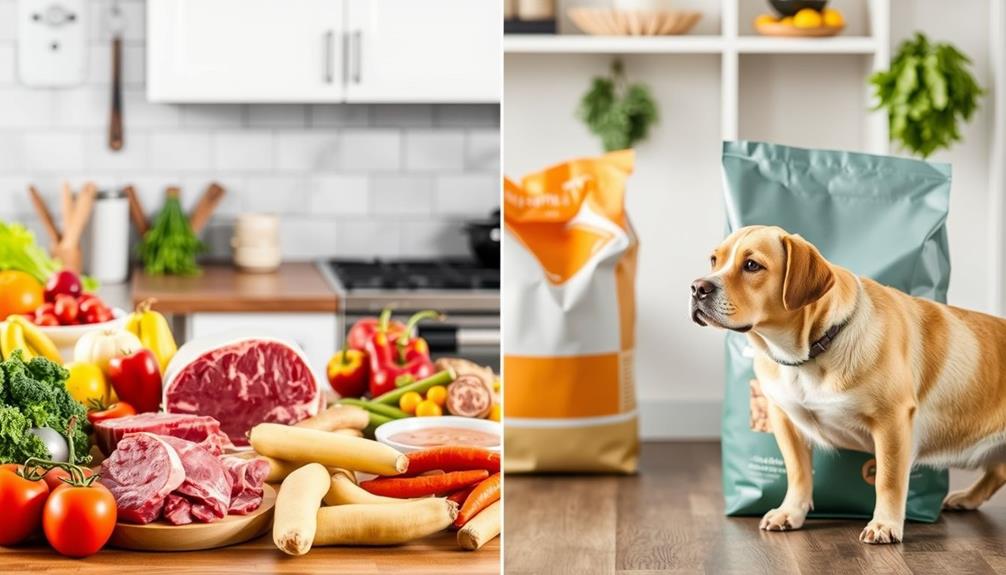
Managing the challenges of a raw diet for your dog can be intimidating. One major concern is food safety; improper handling of raw meat can lead to pathogens that affect both your pet and your family. As a pet owner, you'll need to guarantee strict hygiene practices to mitigate these risks, similar to how caregivers must be vigilant about financial scams targeting seniors to protect vulnerable individuals.
Another challenge is storage; raw diets require significant freezer space and may need separate refrigeration for thawed food, which isn't practical for everyone. Additionally, consistency in diet can be hard to maintain due to the varying availability of raw food formulations. You might find it difficult to provide a stable feeding routine.
Transitioning your dog from kibble to a raw diet must be gradual to avoid digestive upset, and this process can demand patience. Furthermore, raw diets may not offer complete nutrition unless they're carefully balanced. Consequently, consulting with veterinary nutritionists is essential to make sure your dog gets all the necessary nutrients they need.
Understanding Kibble
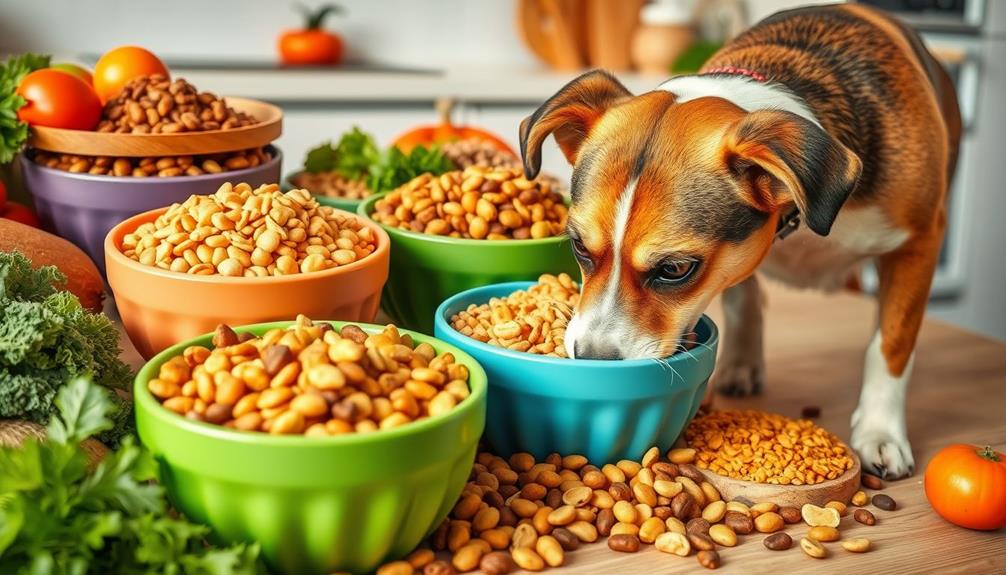
When it comes to kibble, you'll find a range of types that cater to different dog needs and preferences.
Understanding the nutritional content is vital for ensuring your furry friend gets a balanced diet, so you'll want to analyze ingredient lists carefully.
Additionally, knowing the best storage and handling tips can help maintain the quality and safety of the kibble you choose, as proper storage is essential to prevent spoilage and retain nutrients.
For example, keeping kibble in an airtight container can help prevent absorption of odors, much like butter storage essentials.
Plus, knowing the best storage and handling tips can help maintain the quality and safety of the kibble you choose.
Types of Kibble
While exploring the various types of kibble available for your dog, it's essential to understand that not all options are created equal. Kibble dog food generally comes in several varieties, each with its own unique ingredients in kibble. Here's a quick overview of the most common types:
| Type of Kibble | Description |
|---|---|
| Grain-inclusive | Contains grains like corn or wheat, often low-quality ingredients. |
| Grain-free | Focuses on alternative protein sources without grains, good for allergies. |
| High-protein | Features a higher percentage of protein sources, beneficial for active dogs. |
| Limited-ingredient | Made with fewer ingredients, ideal for dogs with sensitivities. |
| Raw-coated | Kibble coated with raw meat or fat, offering a taste closer to raw diets. |
When selecting kibble, pay attention to the first ingredient—ideally a protein source. Processed at high temperatures, kibble often loses essential nutrients, which is why many brands add synthetic vitamins. Always check for potential allergens and avoid low-quality fillers to guarantee your dog gets the best nutrition possible.
Nutritional Content Analysis
Understanding the nutritional content of kibble is essential for making informed choices about your dog's diet. Kibble is a convenient option, but its nutritional value can vary greatly. For instance, the importance of a balanced budget can be paralleled to ensuring your dog receives a balanced diet.
Here are some key points to reflect on:
- Moisture Content: Kibble typically contains only 5-10% moisture, while a raw diet has 70-75%. This dryness can affect hydration levels in your dog.
- Protein Source: High-quality kibble should list a protein source first, indicating it's primarily meat-based. Lower-quality options often contain fillers that dilute nutritional value.
- Carbohydrates: Kibble can have 40-60% carbohydrates, which may lead to obesity and digestive issues since dogs don't need carbs in their diet.
- Synthetic Additives: Due to extreme heat processing, kibble often requires synthetic additives to replace lost nutrients. While kibble meets USDA regulations, some brands may still include artificial preservatives and low-quality ingredients.
Storage and Handling Tips
Proper storage and handling of kibble is essential to maintaining its nutritional quality and guaranteeing your dog's health. To keep kibble fresh, store it in a cool, dry place, ideally inside an airtight container. This protects against moisture and pests that can compromise the food's freshness.
Additionally, guaranteeing proper airflow around the storage container can help maintain the quality of the kibble, similar to how air purifier maintenance enhances performance for clean air. Always check the expiration date on the packaging; stale kibble can lose its nutritional value and may not appeal to your dog.
Once opened, kibble typically lasts about 6 to 8 weeks. If your dog eats slowly, consider buying smaller bags to prevent waste and maintain quality. Avoid leaving kibble in its original bag, as exposure to air and light can degrade nutrients and flavor.
For a safe feeding environment, regularly clean and sanitize your storage container to prevent mold or bacterial growth. This helps guarantee that every meal you serve isn't only nutritious but also safe for your furry friend.
Nutritional Comparisons

Comparing the nutritional profiles of raw dog food and kibble reveals significant differences that can impact your dog's health. Understanding these distinctions can help you make a more informed choice for your furry friend.
- Moisture Content: Raw dog food typically contains 70-75% moisture, promoting better hydration compared to kibble, which only has 5-10% moisture. This high moisture content can be beneficial for overall health, similar to how cranberry juice consumption is rich in antioxidants.
- Protein Quality: Raw diets offer higher bioavailability of protein, averaging 13-14% crude protein, while kibble often includes lower-quality protein sources that can lead to digestive issues.
- Carbohydrates: Kibble can comprise 40-60% carbohydrates, which aren't biologically necessary for dogs and might contribute to obesity and other health problems. Raw Food Diets focus primarily on protein and fats.
- Nutritional Integrity: The extreme heat processing of kibble can destroy essential nutrients, requiring synthetic vitamins and minerals. In contrast, raw diets maintain nutrient integrity through minimal processing.
Feeding your dog a raw food diet can lead to improved skin and coat health, better dental hygiene, and increased energy levels—benefits that are less commonly reported in dogs fed kibble.
Cost Considerations
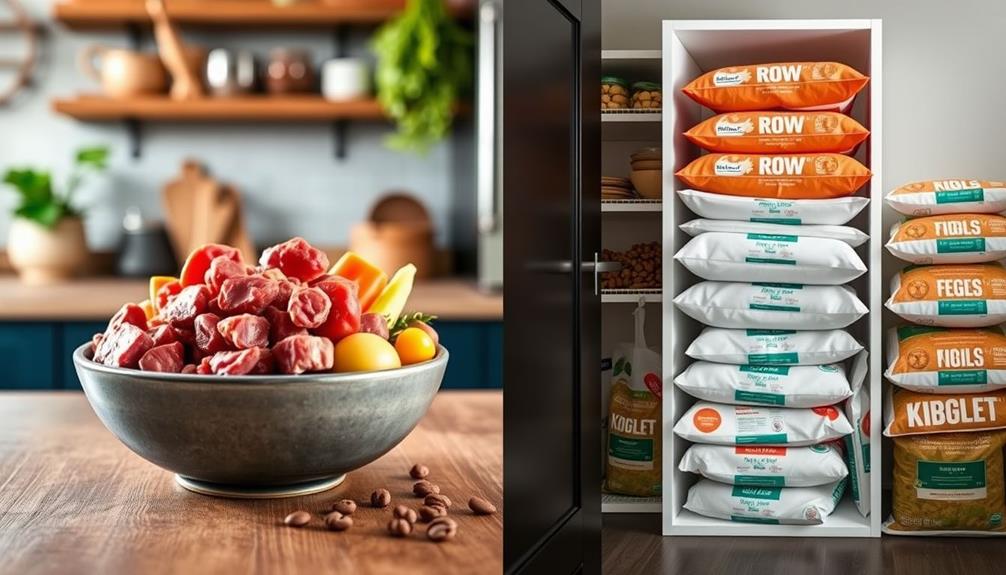
When considering cost, you'll find that kibble generally offers a lower price per pound compared to raw food diets.
However, think about the potential long-term health costs associated with kibble, as they might lead to more vet visits down the line.
Additionally, just as with gold IRAs, it's crucial to evaluate the long-term benefits of investing in your pet's health through proper nutrition.
Balancing your dog's nutrition with a mix of both options could help you manage expenses while still prioritizing their health.
Price Per Pound Comparison
The cost of dog food can vary considerably between kibble and raw diets, impacting your overall budget. When evaluating the price per pound, you'll notice that standard kibble diets usually range from $1 to $13 per day, while raw dog food diets can cost between $3 to $10+ daily.
While kibble appears to be the more economical option upfront, consider the following:
- Quality of Ingredients: Raw dog food often uses higher-quality, more nutritious ingredients.
- Health Issues: Kibble-fed dogs may face more health issues, potentially leading to increased long-term veterinary costs.
- Nutritional Benefits: Raw diets may provide better nutrition, which can positively affect your dog's health.
- Long-term Savings: Investing in raw food could save you money on vet bills down the line due to better overall health.
Long-term Health Costs
Choosing between kibble and raw food involves not just immediate costs but also long-term health considerations.
While kibble can cost between $1 to $13 daily, raw diets typically range from $3 to $10+ daily. Although raw diets may seem pricier upfront, they could lead to lower long-term health costs. Kibble-fed dogs often face higher rates of health issues, resulting in increased vet visits and expenses over time.
Investing in a raw diet mightn't only reduce the frequency of those vet visits due to improved digestion and skin health but also offer significant preventive health benefits.
Studies suggest that the nutritional benefits of raw diets can contribute to a longer lifespan, further decreasing the chances of chronic illnesses that require expensive medical treatments.
Fresh Food Alternatives
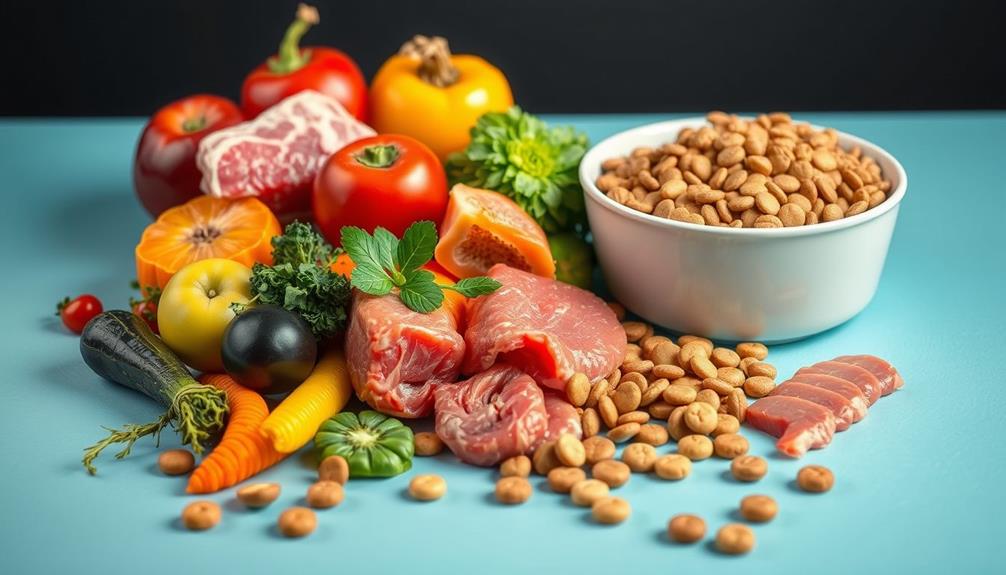
Fresh food alternatives for dogs offer a nutritious and appealing option that can greatly benefit your pet's overall health. By incorporating fresh food diets rich in natural ingredients like beef, chicken, peas, and blueberries, you can promote your dog's health and happiness.
These diets often improve heart health, energy levels, and coat condition, making a significant difference in your dog's liveliness.
Here are some key benefits of fresh food alternatives:
- Nutritionally Complete: Many fresh food services adhere to AAFCO standards, ensuring that meals meet your dog's specific dietary needs.
- Customizable Meal Plans: Subscription services allow you to tailor recipes and portion sizes to your pet's preferences, making mealtime enjoyable.
- Enhanced Freshness: Proper storage and freshness maintenance guidelines are essential for preventing spoilage and ensuring your pet's safety.
- Whole-Food Benefits: A balanced, whole-food approach can lead to improved overall health and well-being, reflecting in your dog's quality of life.
What to Look for in Raw Food
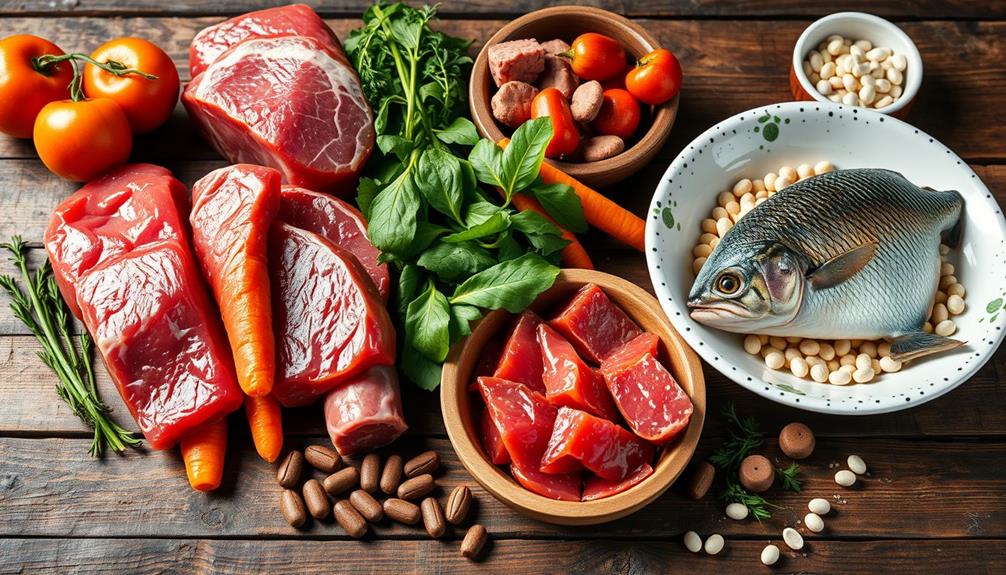
When exploring raw food options for your dog, it's important to focus on quality and variety. Look for raw foods that offer a mix of protein sources, including muscle meat, organ meats, and safe fruits and vegetables. This variety guarantees balanced nutrition, which is essential for your dog's overall health.
Always check if the raw food complies with AAFCO standards, as this assures nutritional adequacy and safety. Transparent labeling is another key factor; it should clearly detail the ingredients and their sourcing, helping you make informed decisions about what goes into your dog's meals.
Consider subscription services that provide customizable meal plans. These plans let you tailor portion sizes and recipes to meet your dog's specific needs, making sure they get the right nutrients.
To further enhance your choices, consult with a veterinarian who understands raw diets. They can guide you in selecting the best food that meets your dog's individual health requirements.
What to Look for in Kibble
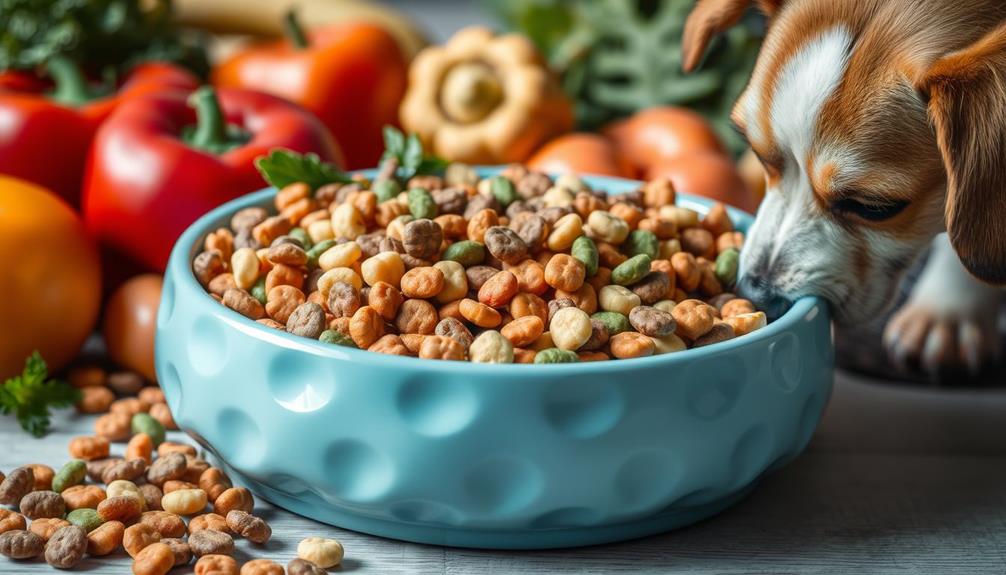
Selecting the right kibble for your dog can be simplified by focusing on a few key factors. By paying attention to these elements, you can guarantee that the dog food contains the essential nutrients your pet needs for peak health.
- High-Quality Protein Source: Look for kibble with a high-quality protein source, like chicken or lamb, as the first ingredient. Avoid options where grains or fillers take precedence.
- Grain Sensitivities: Be mindful of your dog's specific dietary needs. If your pet has grain sensitivities or allergies, choose a formulation that caters to those concerns.
- Ingredient Sourcing: Opt for brands that are transparent about ingredient sourcing, steering clear of those with artificial preservatives, colors, or flavors.
- AAFCO Statement: Always check for an AAFCO statement of nutritional adequacy on the packaging. This indicates that the kibble meets established nutritional standards for pets.
Lastly, research the carbohydrate content; it should be moderate, as dogs require minimal carbohydrates for their overall well-being.
Final Thoughts on Choices
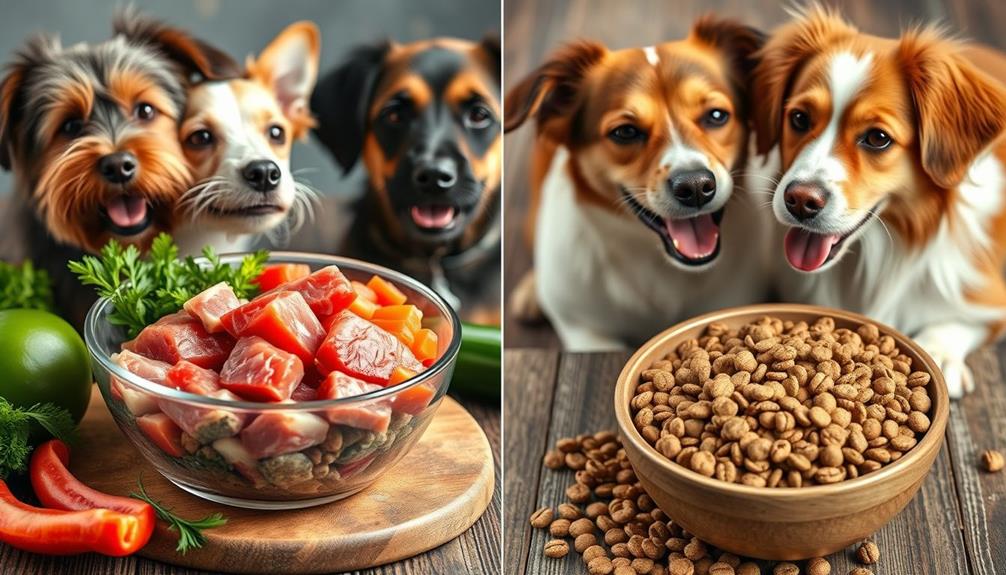
Ultimately, your dog's health and well-being should guide your decision between raw food and kibble. When feeding your dog, consider their individual health needs. Raw food may enhance digestion and coat health due to its higher moisture content and quality ingredients.
In contrast, kibble offers convenience and a longer shelf life, which can be appealing for busy dog owners.
Ingredient quality plays a significant role in this decision. Raw diets often feature whole, minimally processed foods, while kibble can include fillers and artificial preservatives.
It's also important to weigh cost considerations. Standard kibble can range from $1 to $13 daily, whereas raw diets typically cost between $3 and $10+ daily. This difference might influence long-term veterinary expenses, so budget accordingly.
Don't forget to consult your veterinarian, especially one knowledgeable in canine nutrition. They can help tailor a diet that meets your dog's specific needs, whether you lean towards raw food or kibble.
Ultimately, the best choice is one that aligns with your dog's health, your lifestyle, and your budget. Make an informed decision that promotes your furry friend's overall well-being.
Frequently Asked Questions
Is It Better to Feed Dogs Raw Food or Kibble?
When deciding if raw food or kibble's better for your dog, consider their health, hydration, and energy levels. Each option has pros and cons, so evaluate your dog's specific needs before making a choice. Raw food benefits include providing dogs with a diet that closely resembles what their ancestors ate in the wild, which can lead to improved digestion and nutrient absorption. However, raw food can be more expensive and time-consuming to prepare, and there is also a risk of foodborne illness if not handled properly. Additionally, some dogs may have trouble adjusting to a raw food diet, so it’s important to monitor their reactions and consult with a veterinarian if necessary.
Do Vets Recommend Kibble or Fresh Food?
Vets often recommend high-quality kibble for its convenience and balanced nutrition. However, many also support fresh food diets for their potential health benefits. Always consult your vet about your dog's specific needs before deciding.
Do Vets Recommend a Raw Diet for Dogs?
Imagine your dog as a delicate flower; some vets suggest raw diets can nourish it, while others warn of dangers lurking in the soil. Always consult a knowledgeable vet to guarantee your flower blooms healthily.
What Is the Healthiest Food to Feed Your Dog?
You'll want to contemplate your dog's unique needs when choosing food. A balanced diet rich in protein, with minimal fillers, generally promotes better health, digestion, and energy levels, helping your furry friend thrive every day.
Conclusion
In the great debate of dog raw food versus kibble, the best choice ultimately rests in your hands. Just as Odysseus navigated the tumultuous seas, you must weigh the benefits and challenges of each option. Consider your dog's specific needs, your lifestyle, and the quality of the food. Whether you opt for the primal allure of raw or the convenience of kibble, remember that a well-fed dog is a happy companion, echoing the age-old truth that you are what you eat.

